A few shots of the younger moon taken in the cold and snow over the weekend
A bit earlier on, the sky had a pink tint as the sun was setting

and with a passer by
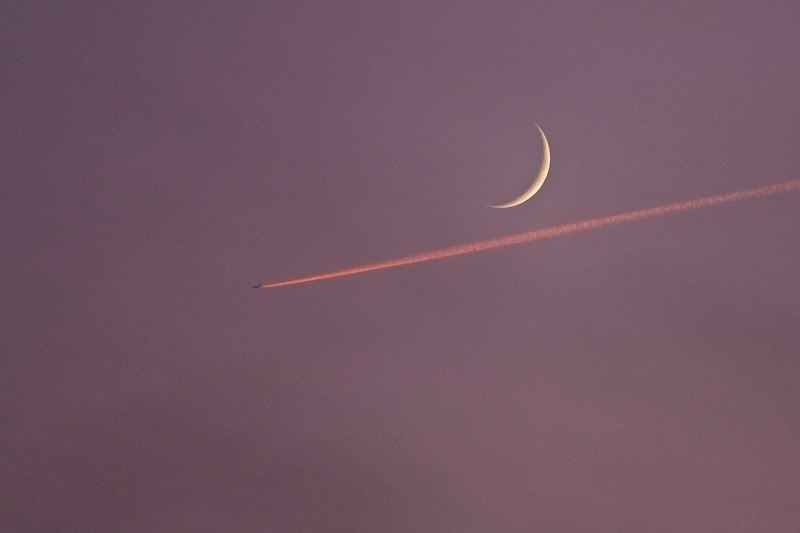
Then a couple from a little later on

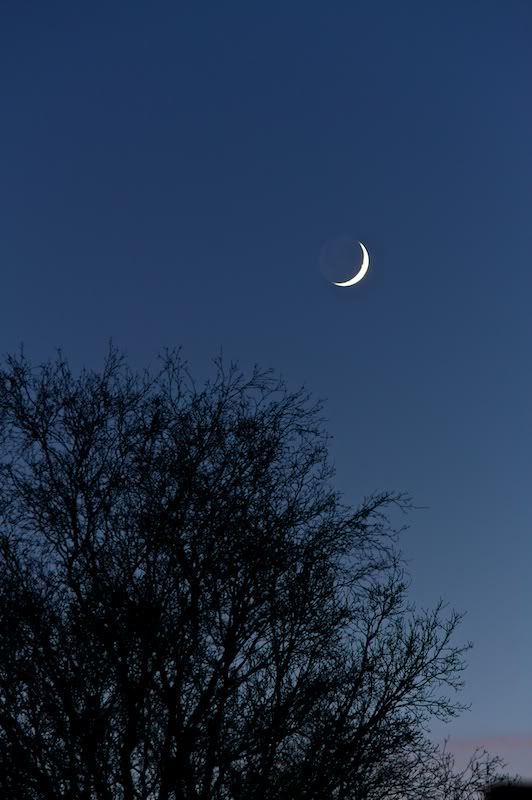
I've not been brave enough to get the gear out, in spite of having some clear skies, as the snow and ice makes the garden hazardous without carrying expensive equipment...
Monday, 21 December 2009
Some Younger Moon shots
Monday, 14 December 2009
The Moon, Geminds and an Older Moon
I managed to get a shot of the moon against the clear blue sky the other morning... Lovely sight it was too
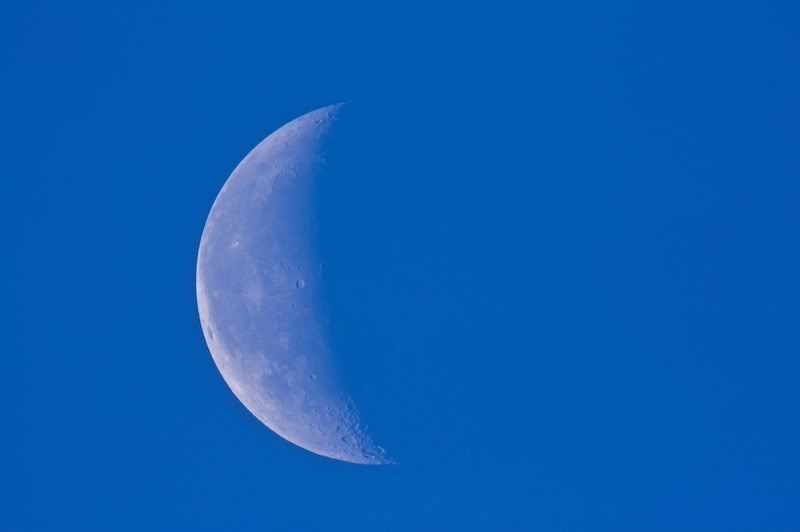
Last night, apart from some clouds whipping through, I went looking for Geminids. In between the clouds. It was a truly breathtaking sky last night.
I sat out with my 10x50's and spent a little while hunting around with the bins, I'm finding it so much easier this year to find my targets. I can't remember the order, but ...
m31, m35, m36, m37, m38, m41, m42, m44, m45 to start with...
Collander 70, the Mirfak association, the cluster around Bellatrix (I'm sure it's another Collander though I can't recall). I think I also found the cluster at the heart of the rosette.
After being sat there for a while, I was amazed to find, that I could, with averted vision, see the little fish, and the smiley face in Auriga, seven of the sisters, and I'm sure I could also make out some of the Mirfak association without the bins. m45 appeared to glow in the sky.
Oh that the cloud had stayed away, and not kept whizzing through, and I almost could have preferred to have got out the rig, given my success (or lack thereof) with catching any Geminids.
But, I enjoyed it, the views were just stunning.
I managed to get 2 Geminids on chip, I'm going to recheck the others and see if I've caught any, but I doubt it.

and
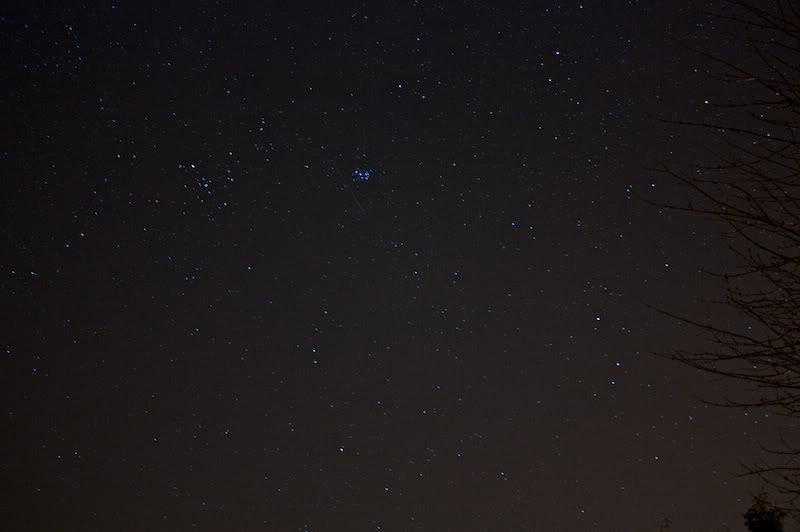
as I had 90 shots... I made a star trails with them. The clouds has made an interesting effect
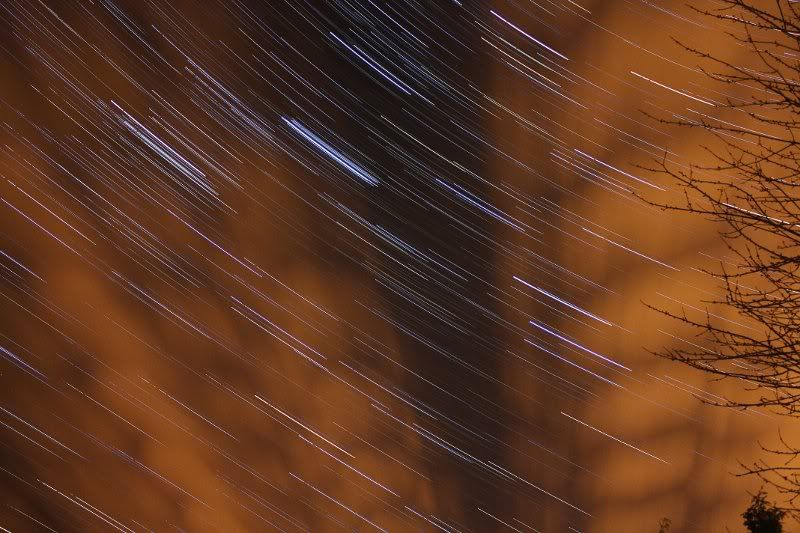
And then this morning, I spotted a 26 day old moon, hanging low in the wonderful colours of predawn
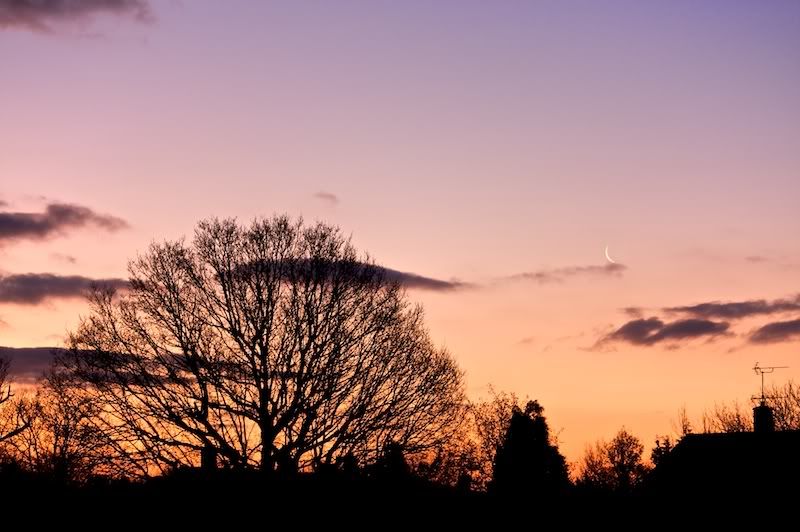
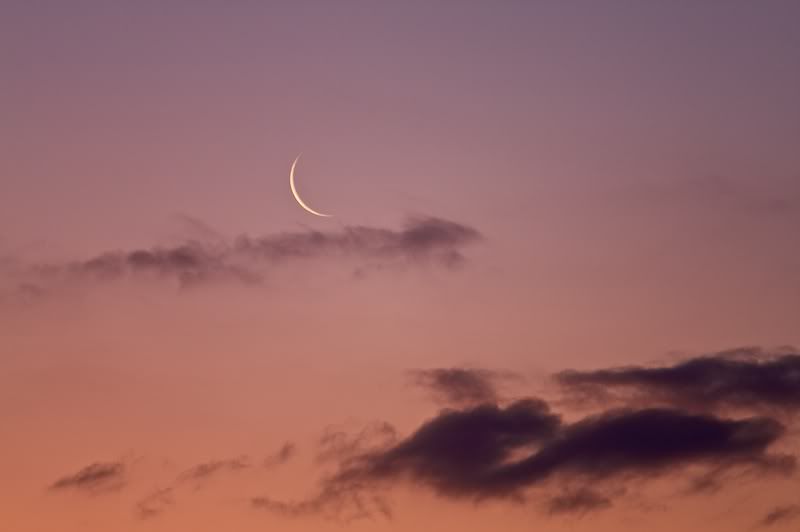
Tuesday, 8 December 2009
Moon in the trees..
Firstly an apology. I messed up with the comments someone was trying to post yesterday, and they got deleted.... Sorry about that. Whoever that was, please don't take it the wrong way... it was my user error nothing more. I've done some digging, and managed to find the setting that caused me to mess this up I think...
I managed to get a couple of shots of the moon as it rose through the trees last night..
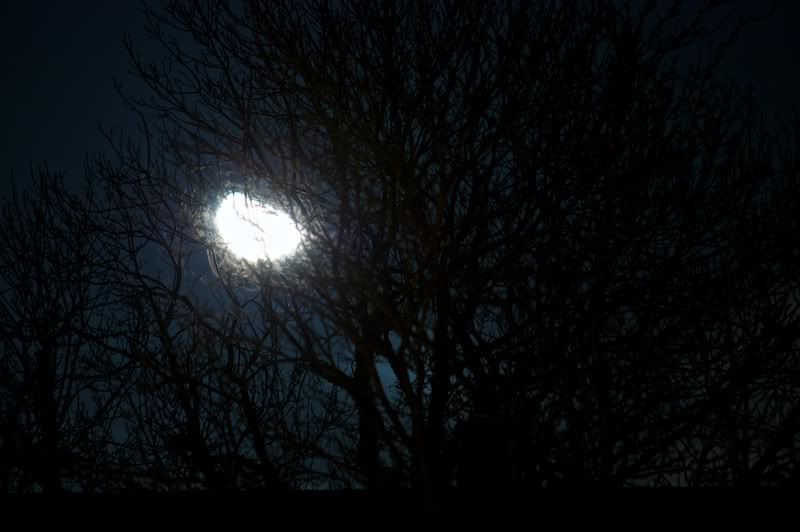

Monday, 7 December 2009
Collimation and a hoop
Had another clear night. I got setup, and decided to have a go at collimating the Skymax. What a pain that proved to be. Firstly, the little Mak has 6 collimation screws, 3 x 3mm and 3 x 2mm using Allen keys to adjust. That makes it tricky to start with, in the day, when you can see what you are doing. At night, that's just painful. Still with the near full moon up, it was quite bright. I started on the moon, to focus and ensure the finder was aligned, as using the QHY5v and a 2x barlow made the FOV of the Skymax particularly small (so small, that an out of focus Betelgeuse filled the screen), then slewed across to Betelgeuse, conveniently close by. I've gotta say, that using EQMOD and a game controller made this really easy. Anyway, I took the Mak in and out of focus and confirmed my suspicions, the rings were not concentric. So, I started in on collimation. Then realised I'd forgotten the instructions, so dug them out and started over. After the first set of adjustments, Betelguese was nowhere to be seen on screen, and no amount of wandering about could find it. I went back to the moon, and realigned the finder, and back to the star. And repeat, and repeat, and repeat. After about 1.5 hours of this, most of the time spent trying to find the star again, the rings were as concentric as I could make them by eye on the laptop screen, and I could no longer feel the Allen keys as I was using them. Needless to say, this is not a good idea and I kept dropping them. Oh, I should point out, the lack of sensation was down to the cold.
At this point, I decided I'd have a go at creating a mosaic of the terminator with the 2x barlow. So off I set. Some time later, and I'd captured 28 panes of the terminator, seems rather a lot, but hey, the shivers were getting silly, it was a bit cold and all the layers I'd stacked on just weren't keep the cold out anymore. So I cleared up.
I was amazed at the difference in the resulting images on each pane..
Here's an example, compare this to Bailly from the previous session...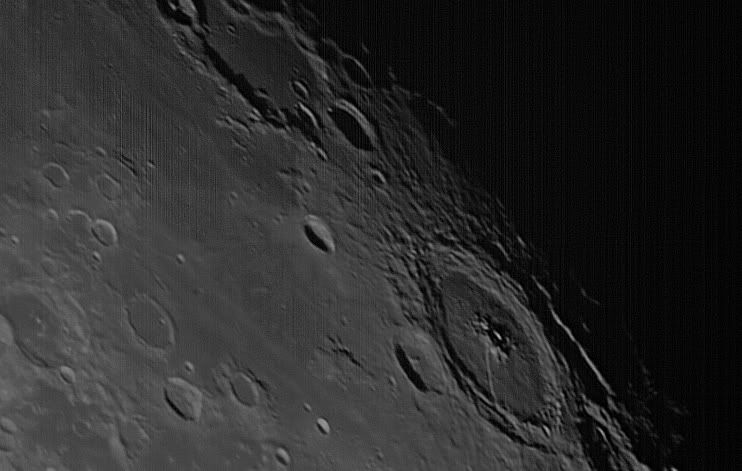
I've got some odd lines in the image, I'm not sure why, but it might be a setting or interference from a power lead, or a number of things, and that'll be something for another night to work out. Anyway... after processing each pane and mosaicing it, I got a far larger image than I'd anticipated.
Click for full size.
I'm very happy with the result, and would like to try a full mosaic using the barlow, but that's for another time and plenty of it. I'm going to need to find some hard disk space too.
The following morning, with the moon low in the sky and the sun not yet risen, I spotted the moon framed in the trees

Thursday, 3 December 2009
Mosaicing the moon
Having proved the camera works well on the moon, finally a clear night (and I mean properly clear), the first in 6 weeks, and I got the little Mak out for an attempt on a full lunar mosaic. Being full moon of course meant lots of segments. Anyway... A quick PA, balance, find the moon, focus and test and I was off. I drove the mount with EQMOD and used the game controller to move around the moon. I used VirtualDUB to check each AVI for alignment and to ensure I didn't miss any bits, I left plenty of overlap. I captured 34 sections. I probably didn't need that many, I actually only used 33 in the final mosaic. After stacking each 500 frame avi in Registax, I put the output into imerge and aligned as I went along. I also captured a few images with the Ultima x2 barlow, for a short string along the terminator and a single image of Bailly. I did try stacking the 2 x2 barlows, and using the x5 barlow. The seeing was not up to this, there were times, I wasn't even sure the seeing was up to imaging without a barlow but it worked out ok.
Anyway, here's the results.
Bailly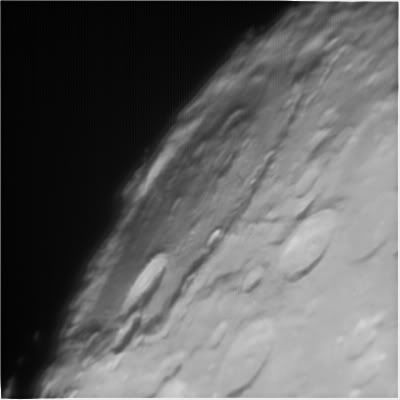
The edge, this is a 5 pane mosaic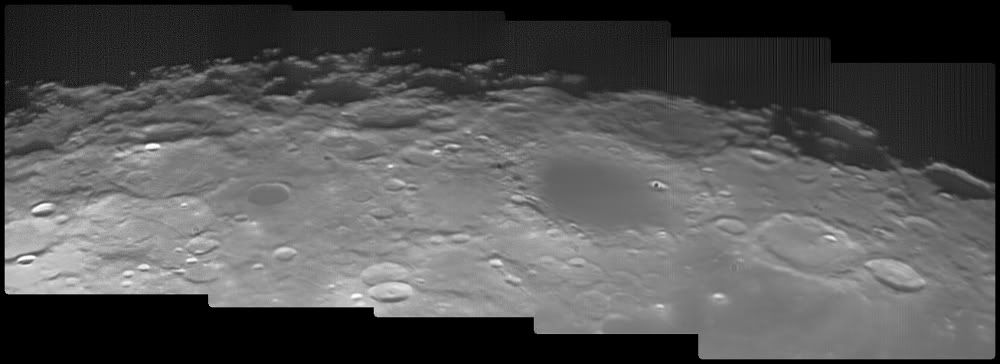
And the full disk mosaic, 33 pane mosaic. 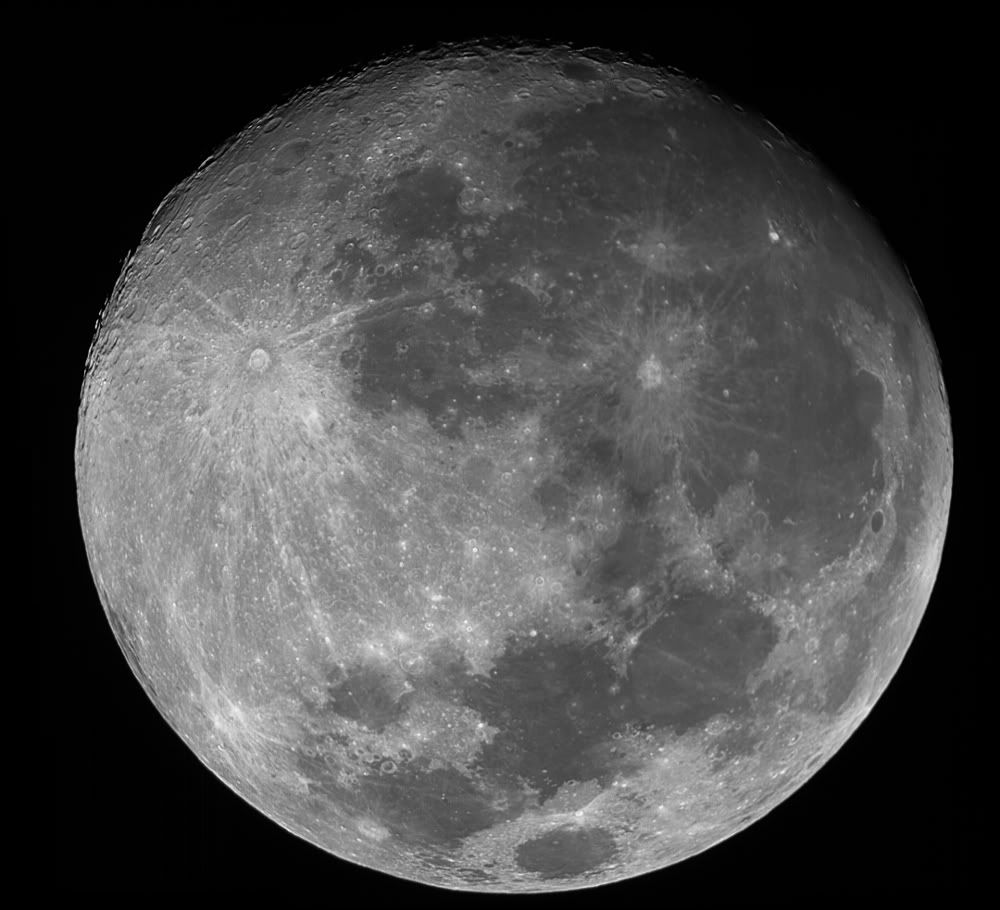
Click for bigger. I enjoyed and needed that, although it was very cold.
Friday, 27 November 2009
Testing...
Been testing out a change in guide camera...
I only got 40 minutes in total, but it's good to know it's working ;)...
Anyway... I installed all the drivers and software during the day, and it was worth it, it was a bit of a faff getting the correct software installed to get the camera working as both a planetary/lunar camera and a guide camera...
First impressions...
1) It's a lot lighter than a DSI, when I was balancing, I was able to balance the kit out with only a 5Kg counter weight, instead of the 10Kg I had been using... Phew... that feels so much better carting it all in and out now...
2) I tested out on M45, a good bright target to make focussing etc easier. I have to say, that I was getting stars showing on PHD with only a 0.2 second loop, so it certainly seems to be a sensitive little beastie for a CMOS chip... Oh, I don't mean the bright sisters.. one or two of the fainter ones were in view also.
I had no problems with the guiding, all worked well. Just a shame that only 20 minutes after guiding locked on, the clouds had moved in and spoilt the night.
I got a short while also testing on the moon. I used the Skymax on the SLT. Hardly an ideal setup, as the tracking isn't spot on, and it wobbles far to easily.. but it's light to carry and very quick to setup. The tracking would have been better if I'd levelled it, but I forgot... Anyway... Some playing later... I've gotta say the frame rate is much better than the SPC900...
A couple at full frame, about 38fps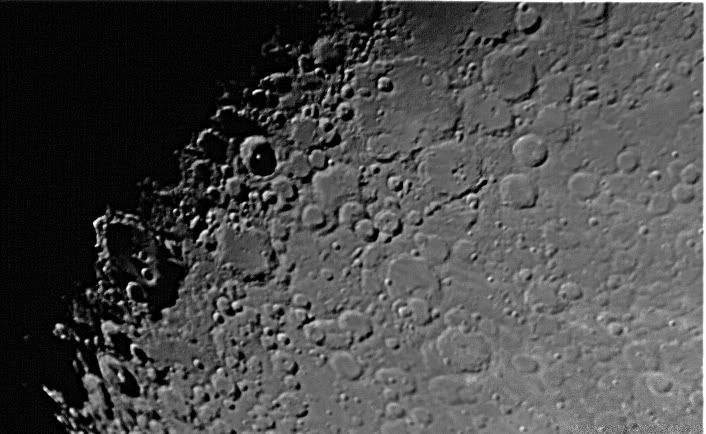
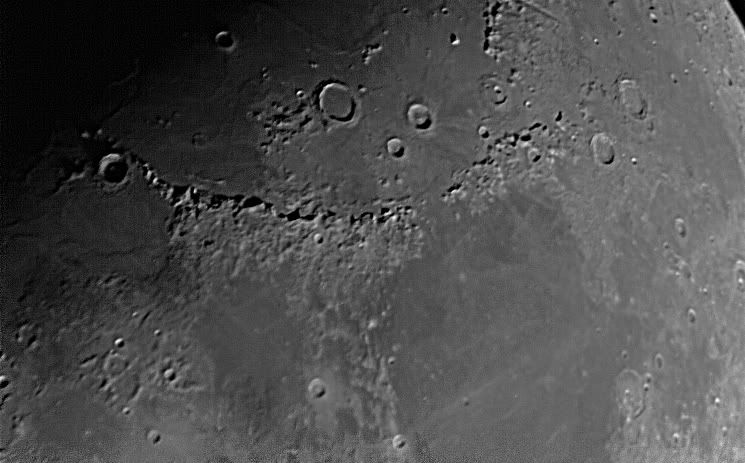
One in planet mode (smaller frame) 53fps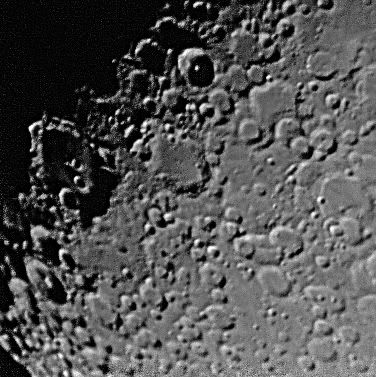
And then just to see what would happen, sub frame, smaller still... this hit 83 fps... 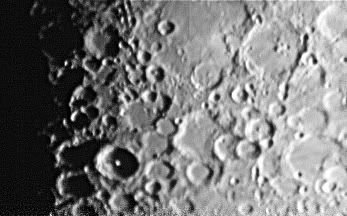
I'm not sure I did a good job on either focusing the scope, or processing the images... just a quick bash through regi5 using frame 1 and pretty much defaults, except for multipoint align.
I have to say I think it does a very good job as both a Guider and as a Lunar Camera. I'd expect it to do a similar job on planets, but there wasn't one to look at..
I did try using barlows (x5, 2 x2 and x2) and the camera is more than sensitive enough for it, but on the SLT I couldn't focus the Skymax.
I did setup to try and do a surface mosaic of the moon... I put the Skymax out to cool. Some time later, the HEQ5, polar aligned and setup, mounted the Skymax, and was just about to go get the rest of the bits and pieces... when the clouds rolled in, so I packed it all away again, carted everything in, just in time to miss the rain that followed shortly after.
Monday, 16 November 2009
What did you do with the sky ?
Where have all the stars gone ? This is really beginning to wind me up now... three weeks of prime long nights and hardly any opportunity to do anything. I've taken my Mak out 3 times now for an attempt to collimate. The first occasion, I left it out to call, when I went back out, it was dripping wet (only took 30 minutes too) and Polaris has gone... The second occasion was much the same, but without the dripping. The third occasion, I managed to get to the point of confirming that the collimation is out a little before the clouds blotted out the sky... I want to finish my M45 image ... And have a go at a few other targets...
I did see most of last nights ISS pass as it whooshed between the cloud banks, the glow of diffusing light from the mist help make up for it, and it was a bright pass too.
Surely this can't go on for much longer... It didn't feel so bad in the summer, as at least it was warm...
Monday, 9 November 2009
A couple of the moon
This weather is getting to me... The clear gaps are not lasting for more than a short while, often followed by bursts of rain, and more clear spells. I'm not going to risk my kit for a short period of clear in the potential for rain. I have been able to get a couple of moon shots though...
One from Friday night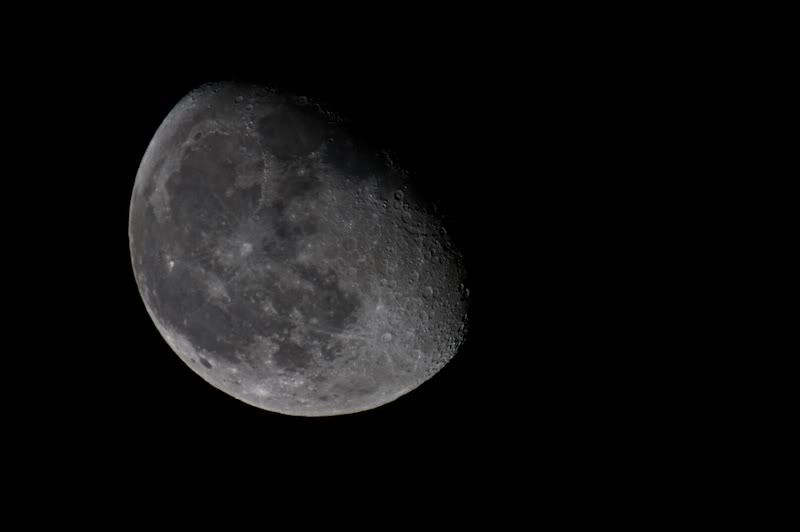
And one from about 10 hours later. It's amazing how in such a short period of time, the view and orientation change so much. 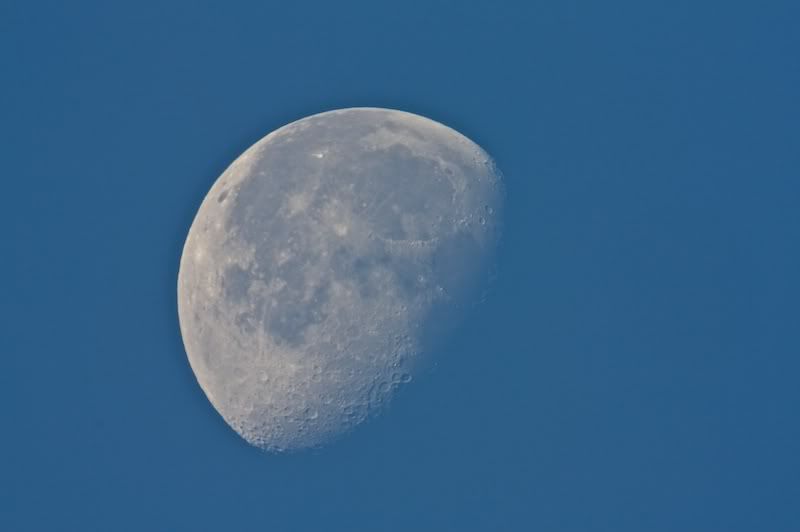
And then last night, I put my little Mak out to check it's collimation on Polaris, cos it looked clear... 30 minutes later, I went back out, clouds had covered Polaris, and my Mak was covered in a film of moisture... never mind...
However, on checking the doors were all locked, I spotted the moon was up, looking out, and there was Mars nearby. What a lovely sight. I got a shot of it, real tough one thanks to the dynamic range...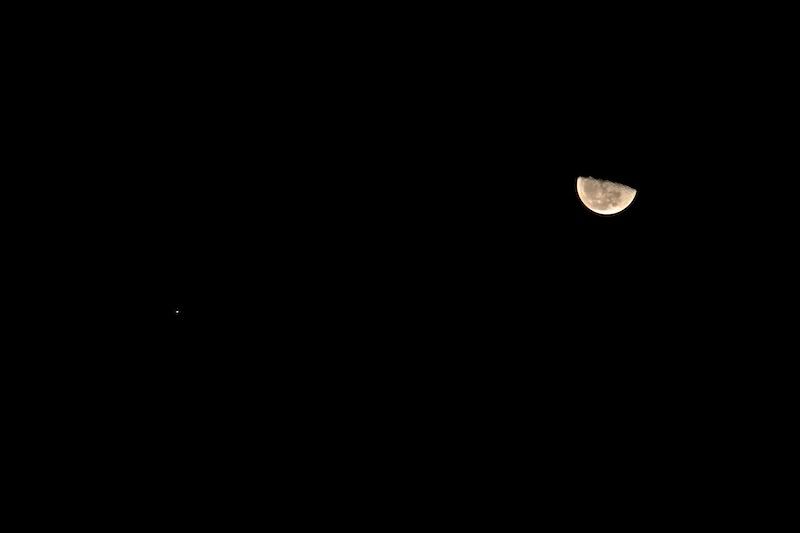
but easily solved, but taking two shots, one for the moon, one for Mars, layering them, and erasing the moon layer where Mars is to allow the bright Mars to shine through. You know what the biggest shame was... the Beehive was sat between them, and it would have been lovely to have got all that buzzing clusteryness in the same frame, but there was no way I was going to achieve that little task...
Tuesday, 3 November 2009
Misty full moon
The skies have been heavy mist, cloud and rain... but it lifted a little for halloween, and created a very atmospheric night... the high mist and light from the moon, blotted out virtually all the stars, but I was able to get a shot of the moon. C80ED, 2xTC, 450d on a camera tripod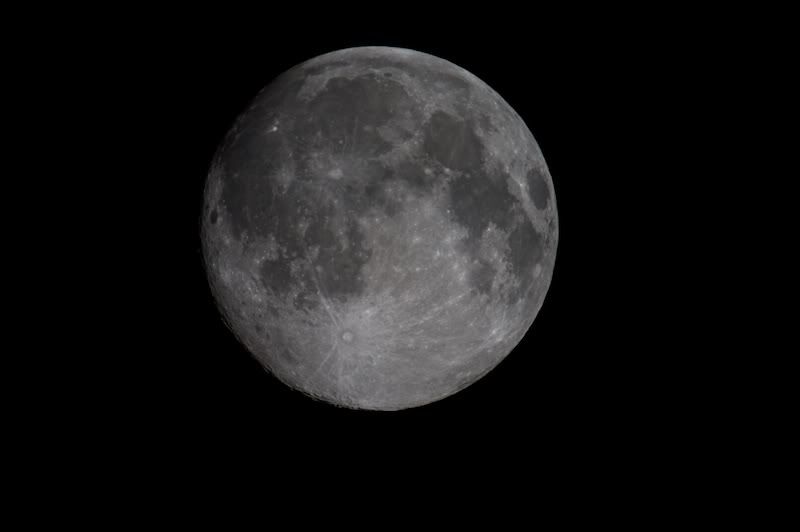
And lift out the colour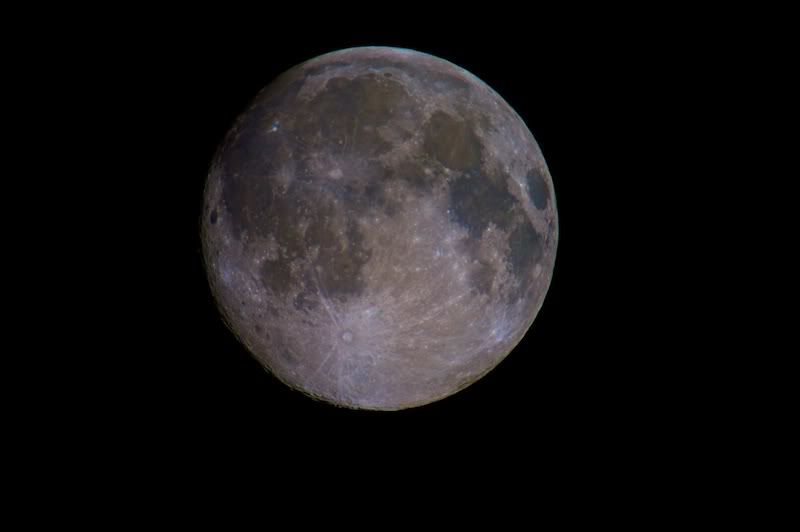
I'm sure I also saw a Lunar Halo. The position would be about right... I tried to capture it on camera, but it just doesn't seem to show in the images...
Friday, 30 October 2009
Some more Moon, some with a difference
Moon and a rose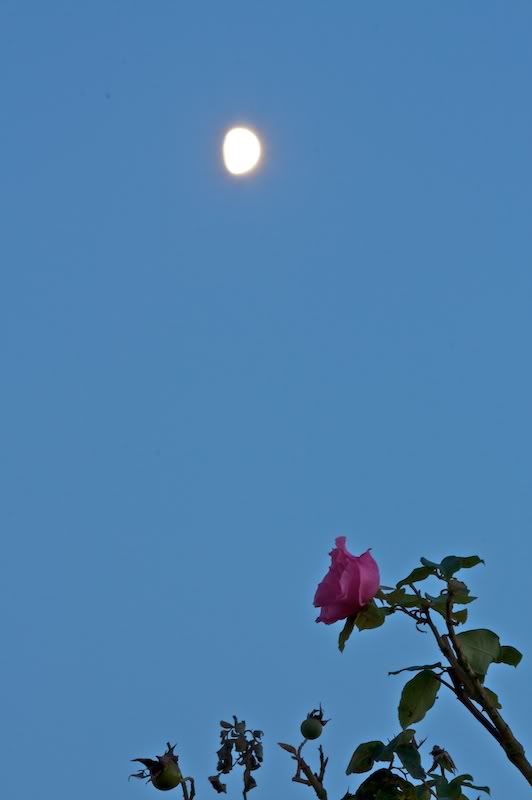
A Misty moon
And the moon from last night, 450d, 2xtc, C80ED on a camera tripod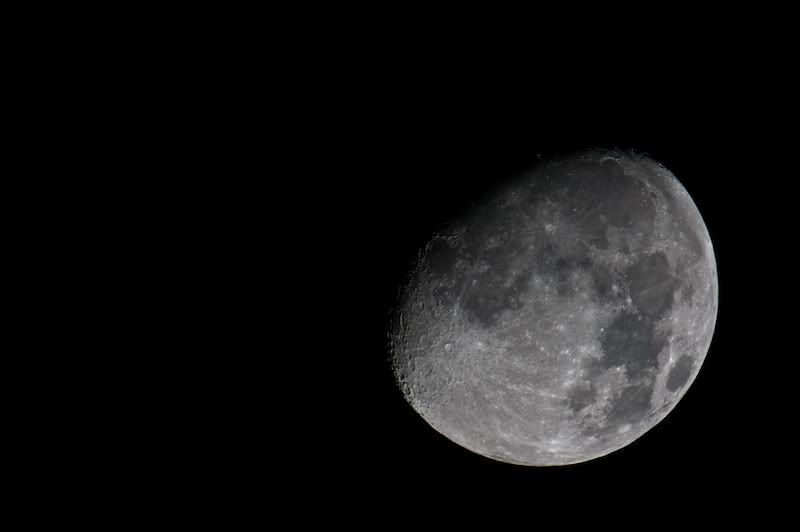
And lifting the colour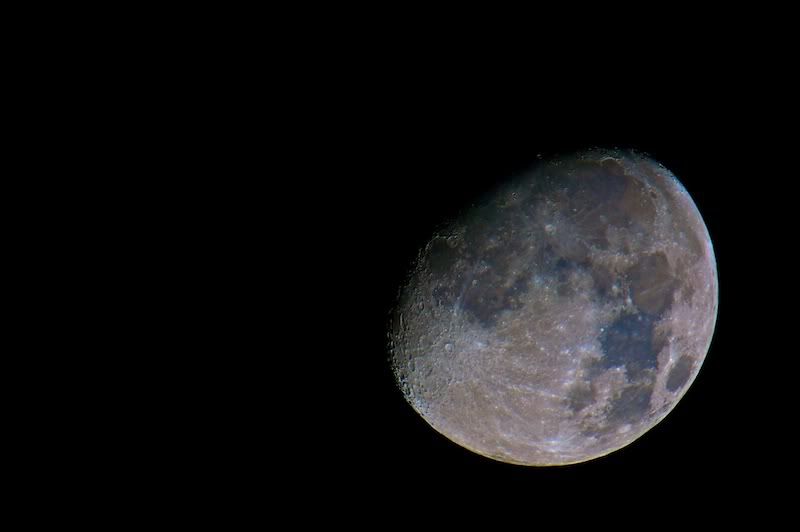
Wednesday, 28 October 2009
More Cloudy Moon, Jupiter and greenery
A couple more from last night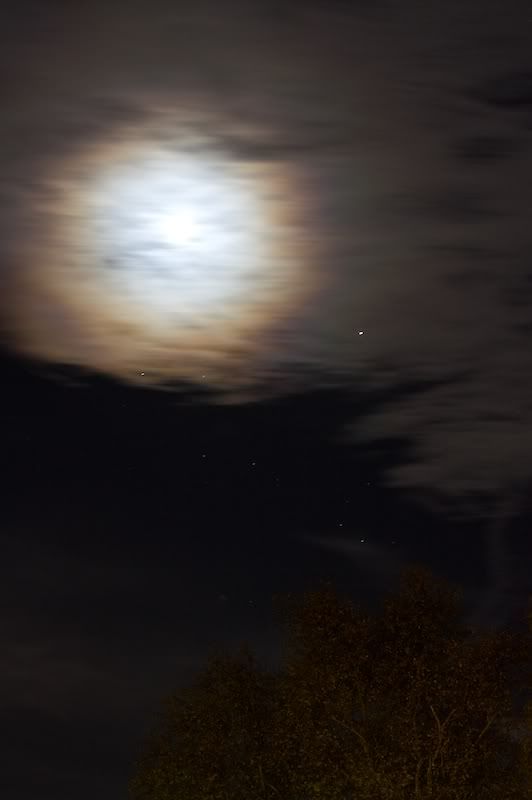

I've entered these two, and the previous one like this into the Galilean nights comp. Along with a coloured moon, a daylight moon and my M45 image.
Tuesday, 27 October 2009
Some Moon and updates
Firstly, a tweak on M31... using highlights/shadows... and a couple of other minor adjustments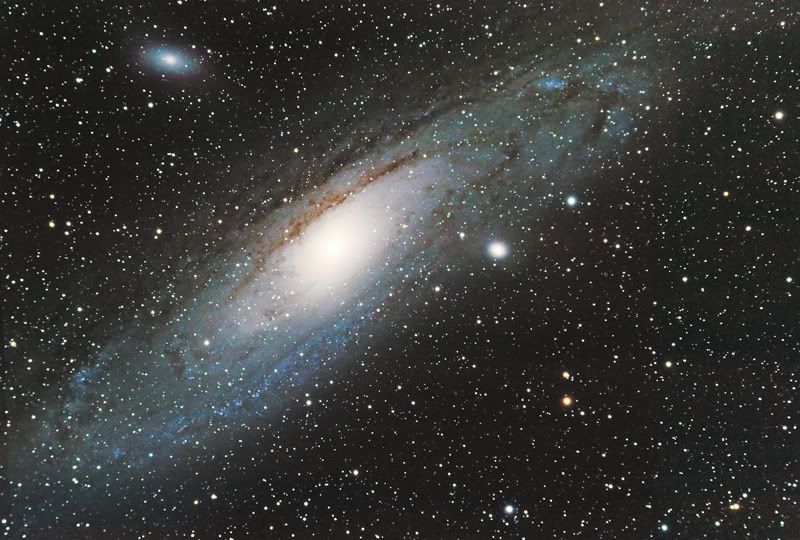
I managed to get a shot of the moon early on sunday, using the 450d, 2xTC, C80Ed on a camera tripod.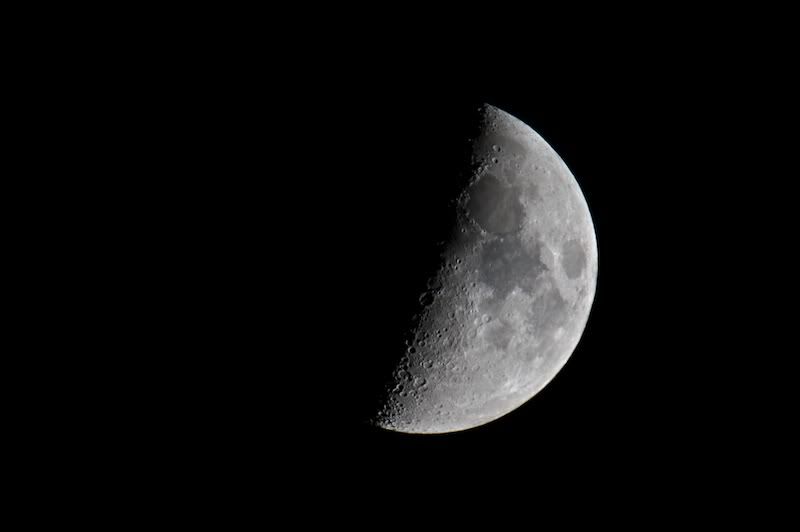
and lifted out the colour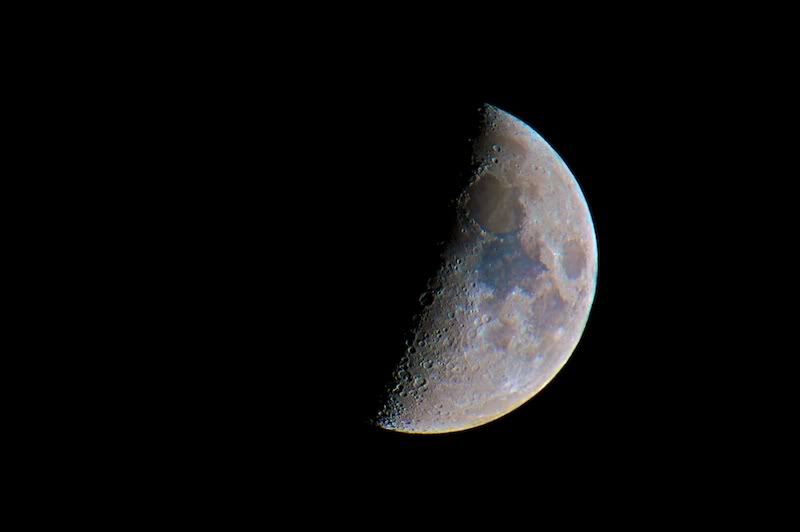
I managed to get setup on sunday night... the sky looked clear. PA'ed aligned, got the camera rotation sorted, started guiding and set the camera running. Checking after 10 minutes, and a big wadge of cloud was moving across, not interfering at that point, but I knew a third sub was out of the question. I stopped after 2 and waited, watching, to see if the clouds would clear.. well after 30 minutes no change, I cleared up. Of course an hour later and clear again... typical...
Anyway, 2 more subs added to my M45 data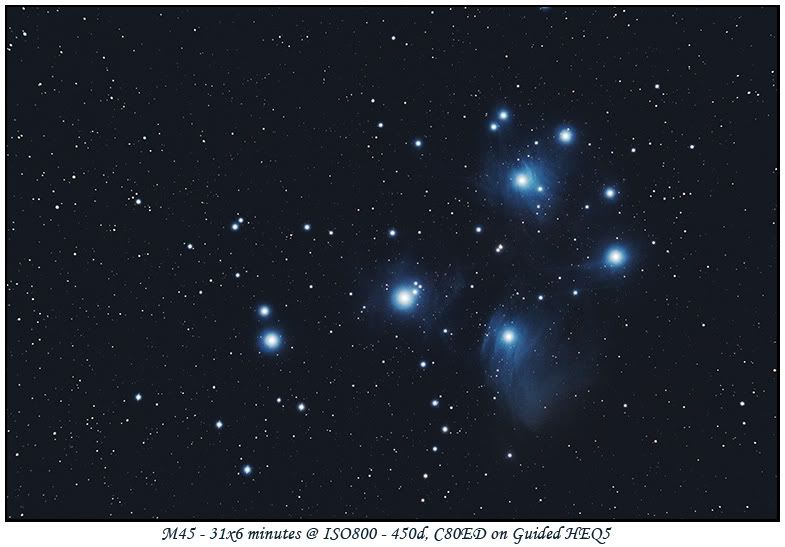
I think, to get anymore out of that, I'd need to get double the subs... to be honest, I'm not sure I'm going to this year... it might be time to go after another target.. M33 seems a good bet...
Then last night, before the clouds set in, I saw the moon and jupiter and got this shot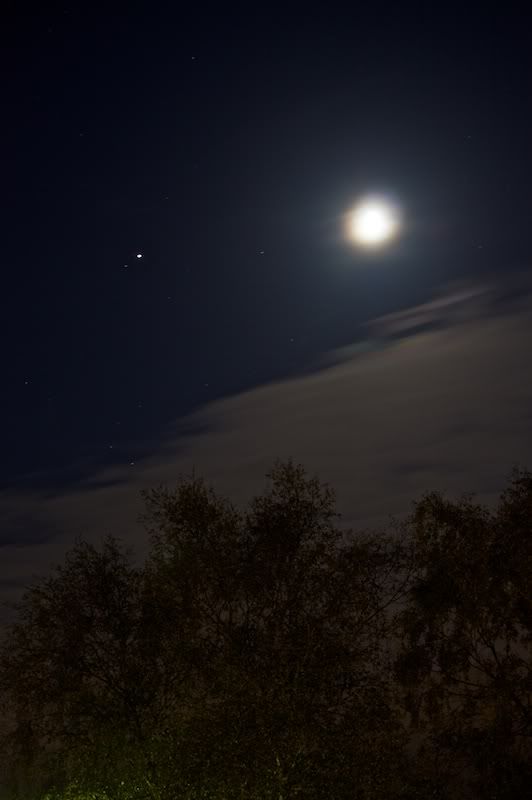
Yes, the moon is a little blown, but it's got the trees in shot nicely and Jupiter is clear... The clouds set in with a vengeance soon after that.
Sunday, 18 October 2009
M31 - 7.5 Hours
Whilst the data was being captured for my M31 image. I spotted Orion and grabbed the 15x70's for a quick look. M42 and M43 were clear, and I could see the wings of M42 stretching off to either side, I even spotted where the running man is (even if I couldn't see the Neb itself)... and had a quick wander around the area.
I also saw my fourth (or should that be fifth, if you include the Earth) planet of the night... Mars was up (below Gemini)...
Anyway onto the image... I lost about an hours worth of capture time when my secondary camera battery ran out, and I hadn't realised... ho hum. After stacking... it took a fair while... with 76 lights and 33 flats, I didn't take darks, or add bias frames...
And processing and some cosmetic tweaking in PS I ended up with 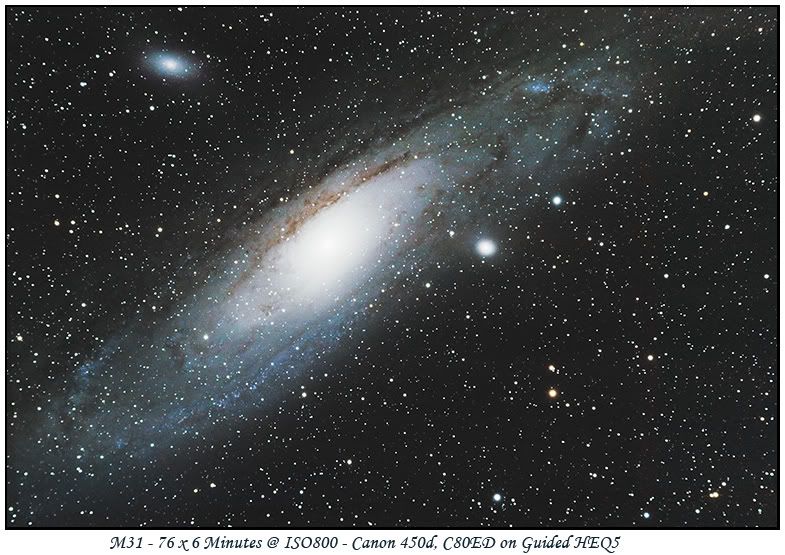
I'm really happy with that result... although I'm sure another 2 or 3 hours of capture time would finish it off nicely.
I found another planet ...
At least I think I did... but I'm getting ahead of myself..
I setup the rig, and set that going... more M31 data... then, after a quick check on Stellarium, grabbed the 15x70's on my tripod and went a hunting..
I started with Jupiter, then on to Neptune... Not unsurprisingly in exactly the same place (or at least that I could tell at this low power :D). Then using Starwalk on my ipod... red screened and auto lock turned off... I went a-hunting along the plane of the eliptic.
Thankfully, using Starwalk, I found some very nice little pointers... a triangle of stars pointing straight at it, and a few forming lines either side... and after looking, and checking, confirm, and look and check... I'm sure I found it... looking just like a star... but if I'm correct... my 8th planet... Uranus..
Yay!!!
During one of the look away, check and look back, I caught a glimpse of something bright, fast and fiery shoot overhead North to South.
I then went and had a look at tonights imaging target, I'm sure I could just about make out M31 unaided tonightm but getting the bins on it, and the shape was clear... the bright core elongating out into an oval.
I spent some 10 minutes, hunting from there for M33, but no luck again tonight... a tough needle to find in that haystack... and starwalk really wasn't of any real use... I'm sure I was pointing the bins to the right patch of sky... ah well...
I spotted Auriga over the neighbours house and went looking for clusters... I firstly found Mr Smiley and the little fish nearby, then studied where his right ear would be, and yep... there's the first one... M38... A little way lower than this and I found M37.
By this point, thanks to spending so long craning my neck to try and find M33, and the cold seeping in through me fleece, I went in for a cuppa and to warm up.
Hmmm... I enjoyed that session too... Even better knowing that I'm imaging whilst observing too..
Friday, 16 October 2009
M45Reprocess
I had a bash at reprocessing my M45 data during the clouds... been plenty of those this week...
It's getting there, but there's still quite a lot of noise in the image. I really need more subs to add in, and I think this is as far as I can take my existing data. Hopefully soon... I really want at least another 4 hours to add to this...
20 minutes between the clouds.
At 9 it was cloudy...
At 10 it was clear... but a quick check around showed clouds on west and northern horizons, at least what I can see of them. I wanted to get the rig out for some more time on M31 and M45 but with those clouds... no point... So I set the 15x70's on the tripod and stepped out for a whirlwind style wander around the sky...
First off Jupiter.. Riding high, with a trail of three moons down to the left, although, checking the charts... it was actually all 4 but the 15x70's couldn't seperate 2 of them.. Io in close, Europa and Ganymede, appearing to be one and Callisto way out... A very pretty, the king with his train of servants...
Anyway, using Stellarium, I went looking for Neptune... I found the 3 stars in a line, a quick double cross check (that's looking at 2 sources, rather than a double cross...) and there it was... Netpune... yay... Another planet on the list... Only one left to find.. I had a look around in Capricorn for the other M's but I couldn't find them.
So instead, I turned around and went to remind myself what some of the other sights looked like, that I haven't looked at in a long time... First up... gotta be M31... very clear, a bright core and a faint wisp/hint of something around the core... although my mind might be filling in the blanks for me... I had a good look for M33 too, but again, couldn't find it. Perhaps I should've referred to a book, but as I didn't have one with me ...
I thought to myself, that one of my favourite, yet really odd sights would be very clear now. And it was... Kembles cascade, a line of about 20 stars leading into an open cluster, NGC 1502. Lovely... (it's easy to find... follow the top of Cassie sort of straight down, alongside Perseus, about double the distance of the width of the top of the W).
Then onto the Double... A wonderful sight, but Bins really do bring this out nicely... I swear I could see some reds in the stars... I don't think that's due to odd reflections from my red head torch either... it was only 3 or 4 stars showing it... From there down to Mirfak and the Association... I previously would centre on Mirfak, but I discovered tonight how much I'd been missing... By putting Mirfak to the upper edge of the FOV, I found so many more stars than before... WOW!!!..
From there I hopped across to M34... another one I found easily... nowhere near as impressive as the double, but still a lovely little cluster. Back down into Auriga... I didn't fine the M's but the conditions were deteriorating, but I did find Mr Smiley and the Little Fish. Back up to Cassie (just sort of meandering) there are so many stars, but I found M103... Then NGC457, The Owl cluster. I swung around a little, hopped up from the pan of the dipper, and found M81 and M82... A pair of very faint smudges in the bins... Glad I found them though, I normally have a lot of difficulty doing that.
Then I turned around, found the coathanger... had a quick nose at Lyra... although 15x70's don't reveal very much and drifted up the Milky Way...
That's when the clouds really started making their presence felt (I'd worked around them till then) and gave up and came in...
Only 20 minutes, but well spent and I enjoyed it. I hope to have many evenings with the 15x70s gadding about, whilst the rig is running.
Thursday, 15 October 2009
Another clear night
Although I was unable to start early, I was able to get straight onto more data on m45. But only a couple of hours, then the power ran out...
Anyway, stack and process, I ended up with 
The colour is better, but I've over done something in the processing... not sure what exactly, and I'm not sure I'm going to go back and reprocess at this point, as I want to get even more time on it, I know there is faint stuff lurking in there, just out of reach... I may have to push the exposures even longer.
I had another bash at the M31 data, and I think I've processed this better... although again, more data won't hurt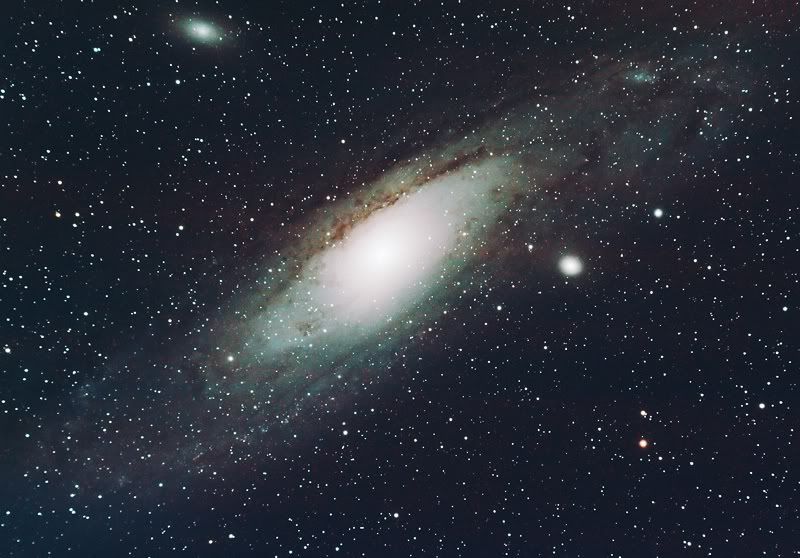
Monday, 12 October 2009
More M31 and some M45
Another clear night last night.. this can't be right, that's two in under a week. Not that I'm complaining of course. Anyway, I carted the gear out for another session, aiming to capture more data on M31. A quick level and PA, hook up the wires, 3 star align, goto M31 and I'm off. I managed to capture 20 more 6 minute subs by which point the camera was looking worryingly close to the leg. I did consider flipping over and carrying on, but M45 was clear, high in the sky, so I thought I'd have a go at that too.
Anyway... After a stack (adding in the second nights data) to give 37x6 mins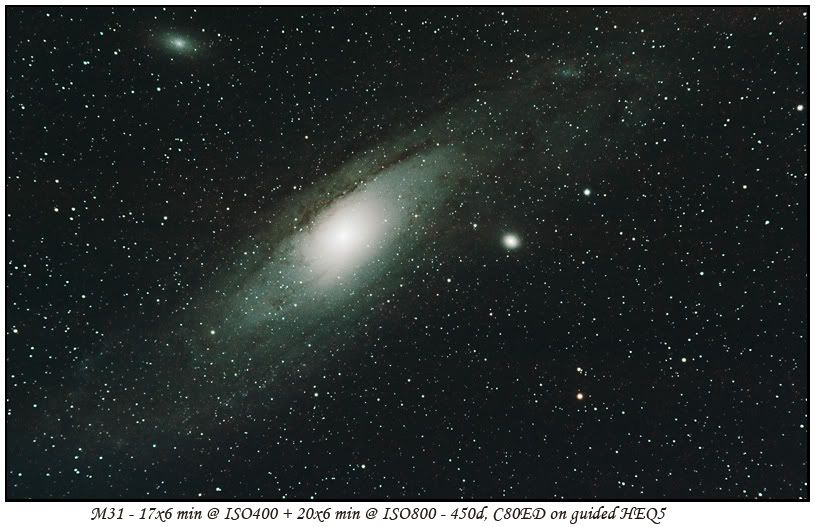
I'm not sure I quite nailed the processing, it needs a little more work, although more data won't hurt...
Here's the stack of M45, only got 11 frames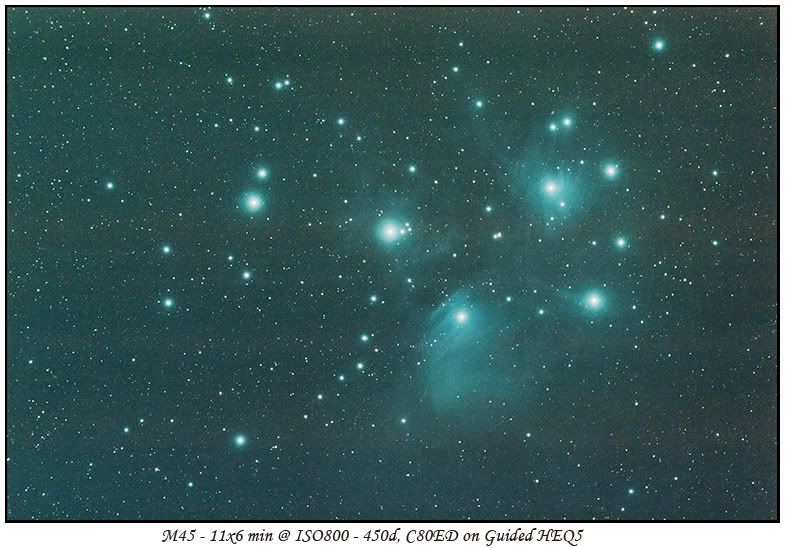
This needs more data, but it's clear that 6 minutes is a good frame length for the whispy stuff, but I might go longer..
Sunday, 11 October 2009
A general update
It's been a while since I've had an opportunity to post, so this is going to cover a few items.
So firstly, There was a close conjunction of Jupiter and the moon, so I grabbed a shot at 250mm
And just to check I could still do it, a handheld 250mm shot of the moon
Over the course of the last couple of weeks, I've been able to grab a few shots of the moon with the 450d, a 2xTC, the C80ED and my camera tripod
and in colour, testing out some of the features of Aperture, I think this is possibly my best to date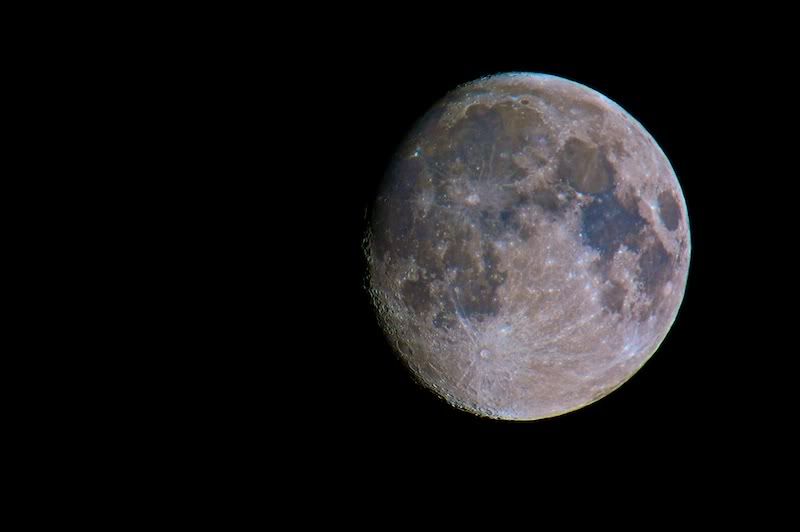
One on a misty night, the mist processes out nicely with a wallop of contrast
but here's the unprocessed version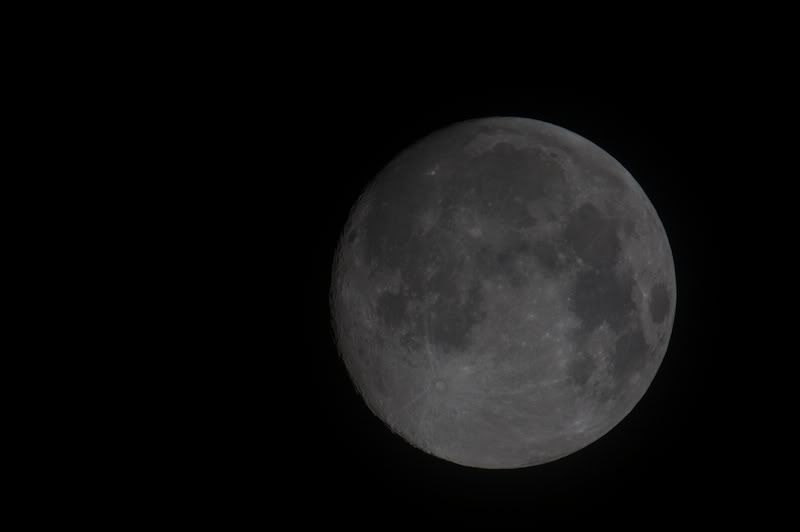
And then, a lovely moon against the daytime sky
I was also able to get out for a little webcam action in between the clouds one night. Thankfully, the Skymax SLT combo, is small, lightweight and very easy to setup, as this means it can be done very quickly without any need to see Polaris.
These are not great, but if I remember correctly, the clouds were being a pain. I'm also at about the limit of my little webcam, I'm not sure what to do really, I'd like an imaging source cam, but that's not going to happen at the moment..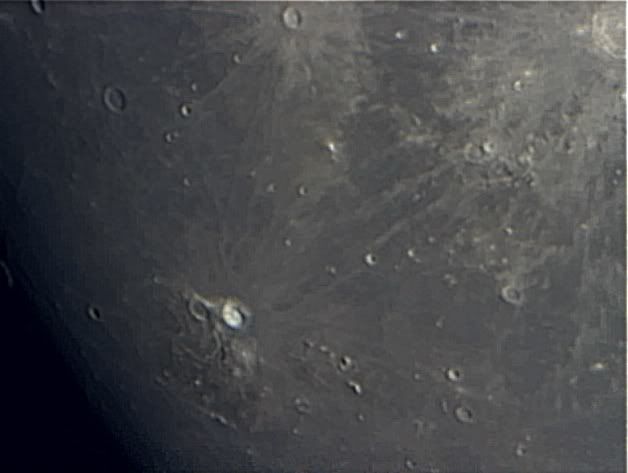
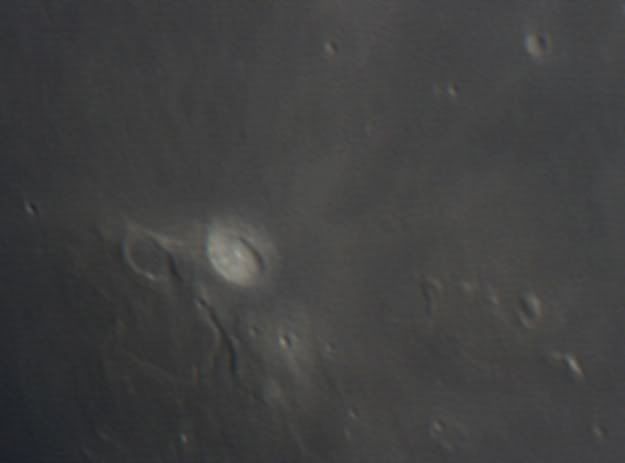
I don't know why, but I really rather like this area of the moon.
I also had a short visual session with my youngest one evening, before the clouds moved in. Jupiter was low in the sky, but we'd been talking about it, why the moon and Jupiter were lit when we had night time, and that you could see the main bands quite easily. So I got the C80ED setup on my camera tripod on the driveway and we had a good look at Jupiter and the moon with my 5mm Hyperion. The bands on Jupiter were clear and three moons were visibly. I did try pushing the power up with a barlow, but the seeing, and the lowness meant it was way too much power. But never mind. With the simple expedient of drawing a line on the drawtube with a pencil, putting the scope back into focus for the SLR was a doddle, and in fact, it turns out that the Hyperion with diagonal is almost parfocal with the SLR and 2" extension tube.
And finally, we had a clear night, decently clear too, so that I could see the milky way unaided. I couldn't quite make out M31. So I carted out the rig for a run on M31. Everything started well, level and PA'ed easily. A quick check of focus and all good. Manually set to M31, but not on the chip... I decided I couldn't be bothered trying to work it out (what with lights still being on in the house, so setup CdC and ran a 3 star align. The first problem hit me... The joystick on the gamepad only worked on one axis... Gonna have to see if I can fix that. Using the touchpad on the laptop for fine adjustments is a real pain. Still after a few minutes, all aligned, so slew to M31. Plonked almost in the centre of the viewfinder, so a quick ISO1600, 60s test frame to check, and I set PHD off to work. Using a 1 sec loop was more than enough to locate a guide star, in fact, I could see the core of M31 on the screen. Anyway, guiding off and running, I setup to take a sequence of 6 minute exposures. I opted to use ISO400 as an experiment, and to see if the higher dynamic range of the sensor would make any difference, it did, but more on that shortly.
After a while, and a check on power, I realised the battery on the lappy was going to run out, way before my powertank... that's a first, I'm not sure why, but my powertank now seems to be working better. I really do have to sort out mains power, but I want to get a large plastic container big enough to house the lappy and keep the dew off, although the simple expedient of hanging a tea towel over the LCD worked a treat on this occasion.
Then I hit my next issue. Whilst taking flats, the CLS is making for much longer flats, the CLS clip filter, decided it didn't want to clip anymore, and I heard it fall down inside the OTA, bouncing on the baffles as it went. All I can see is it's a good job the baffles were there, as they prevented the filter smacking into the back of the objective. Of course, with the clip filter no longer in the camera, there was no point trying to capture any more flats, if I tried to put the filter back, the orientation would be different. I removed the camera, and capped it, popped the rear cap on the OTA, and carefully pointed the lens at the Zenith... the filter fell back on the soft plastic of the rear cap, undamaged... phew...
Then after clearing up, I downloaded the images, and set to work on processing. Then the problems really began. I kept getting a weird grid showing through the image. First stack was Lights and Flats, as I've done for the other images. Obviously something was going on, so I put my Bias master frame in, still there.. Odd... I setup the camera in the garage and took a sequence of darks, still there. Each occasion, involved two attempts at processing post stack. In the end, I took the final stack, and tried to be as gentle as possible, yet push the data as far as I could (all good processing experience) and I managed to not bring the grid out. The noise was astonishing, given that ISO400 should induce less noise in the subs. I can only conclude that whilst ISO400 is less noisy in capture, the lower amplification of the signal in camera meant that to get the data out required far harder stretching, and I know from ordinary underexposed captures, this shows a lot more noise in the shadows...
After that experiment, I'm going to go back to using ISO800 and stay there. The noise and image is easier to deal with... Anyway, here's the end result. 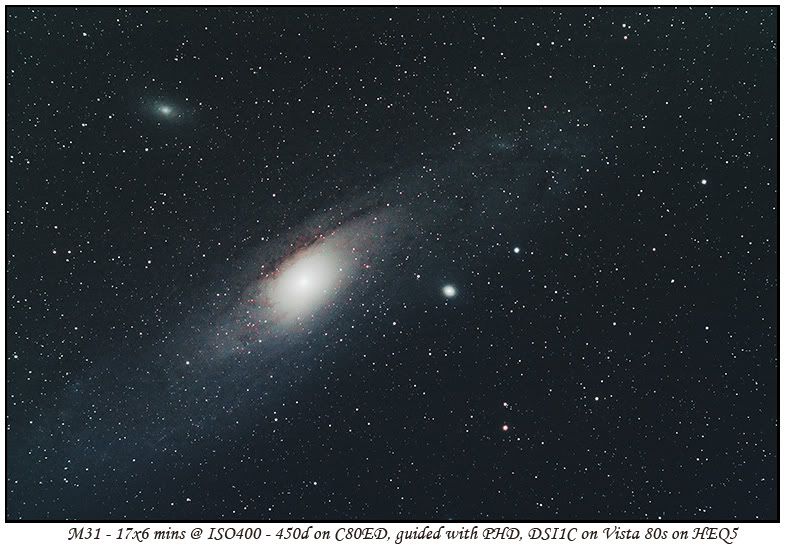
Now, I want to get more data on this one, another night at ISO800 should do it... Then onto M33, and after that M45... I want to get the Merope Nebula.






